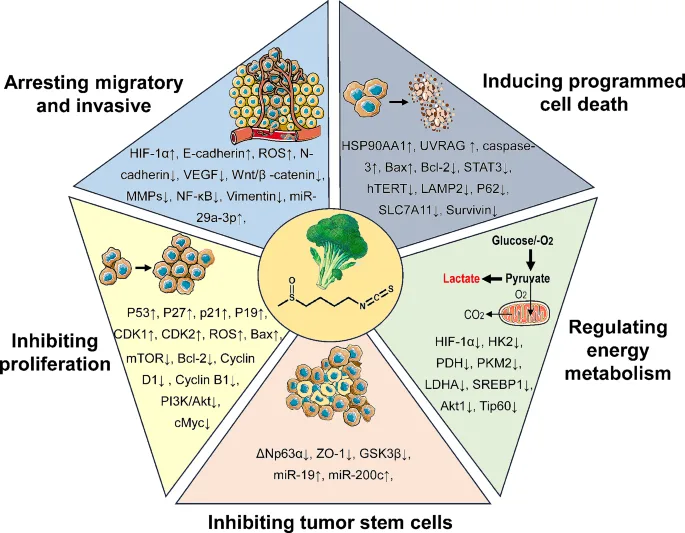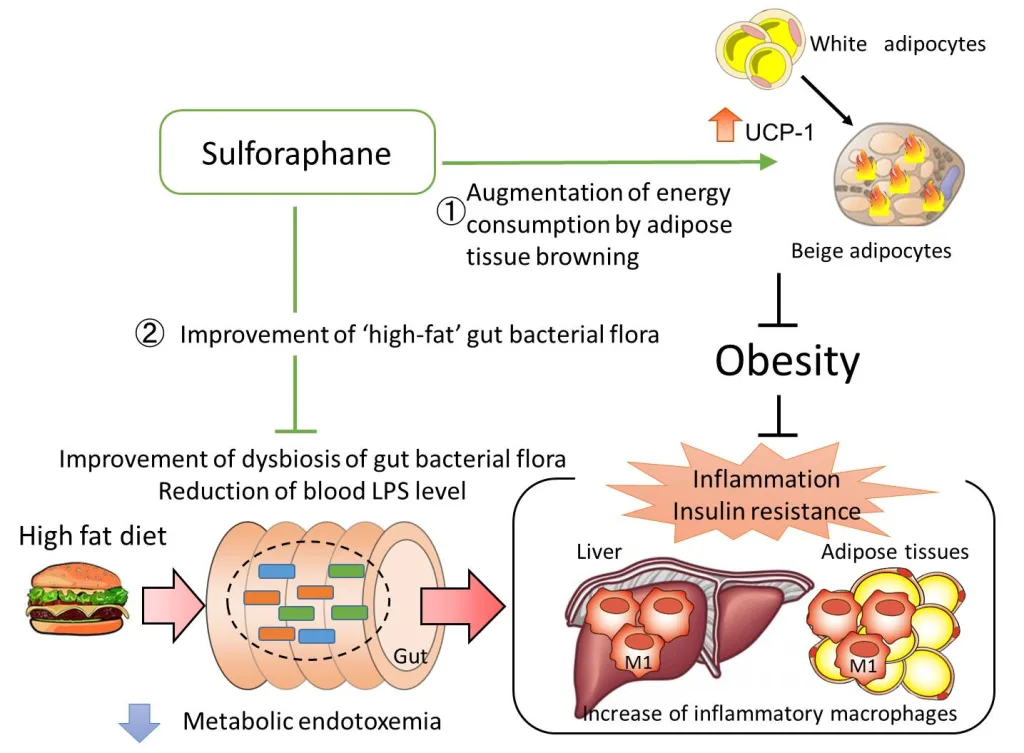Sulforaphane, a bioactive compound abundant in cruciferous vegetables like broccoli, has emerged as a promising natural agent in cancer prevention and treatment. Recent research, including studies by Harbin University of Commerce’s Life Science and Environmental Research Center, has uncovered its multifaceted anticancer mechanisms, highlighting its potential to disrupt cancer growth at the molecular level.

1. Activation of Detoxification Pathways
Sulforaphane’s primary mechanism involves activating the Nrf2 (nuclear factor erythroid 2-related factor 2) signaling pathway. This pathway upregulates Phase II detox enzymes, such as glutathione-S-transferase and NAD(P)H:quinone oxidoreductase. These enzymes neutralize carcinogens and reactive oxygen species (ROS), preventing DNA damage and reducing the risk of oncogenic mutations. By enhancing the body’s endogenous detoxification system, sulforaphane acts as a shield against environmental and dietary toxins.
2. Inhibition of Carcinogen Metabolism
In contrast to Phase II enzymes, Phase I enzymes (e.g., cytochrome P450) convert procarcinogens into their active, DNA-damaging forms. Sulforaphane suppresses these enzymes, blocking the metabolic activation of carcinogens like polycyclic aromatic hydrocarbons (PAHs) and heterocyclic amines. This inhibition reduces the formation of electrophilic intermediates that initiate cancer development.
3. Induction of Apoptosis and Cell Cycle Arrest
Sulforaphane triggers programmed cell death (apoptosis) in cancer cells through multiple pathways. It upregulates pro-apoptotic proteins (e.g., Bax, caspase-3) and downregulates anti-apoptotic proteins (e.g., Bcl-2), creating an imbalance that leads to cell death. Additionally, it arrests the cell cycle at the G2/M phase, halting division and tumor proliferation. This dual effect has been observed in lung, esophageal, and gastric cancer cell lines.
4. Suppression of Angiogenesis and Metastasis
For tumors to grow and spread, they require a blood supply and the ability to invade surrounding tissues. Sulforaphane disrupts this process by inhibiting vascular endothelial growth factor (VEGF), a key promoter of angiogenesis. It also reduces cancer cell motility and adhesion by targeting matrix metalloproteinases (MMPs), enzymes critical for metastasis. These actions limit tumor expansion and distant spread.
5. Epigenetic Regulation
Emerging evidence suggests sulforaphane modulates epigenetic marks linked to cancer. It inhibits DNA methyltransferases (DNMTs) and histone deacetylases (HDACs), reversing aberrant methylation and histone modifications that silence tumor-suppressor genes. By reactivating genes like p53 and PTEN, sulforaphane restores cellular control and prevents oncogenesis.
Clinical and Preclinical Evidence
Laboratory studies demonstrate sulforaphane’s efficacy against various cancers:
- Lung Cancer: Enhances chemotherapy sensitivity while reducing toxicity.
- Esophageal Cancer: Inhibits cell proliferation and induces apoptosis.
- Gastric Cancer: Blocks inflammation-driven carcinogenesis.
However, human trials are needed to confirm these effects in vivo. Dietary intake (e.g., broccoli sprouts) provides lower doses than those used in lab settings, making standardized supplements a potential solution for therapeutic use.
Future Directions
Researchers are exploring combination therapies, such as pairing sulforaphane with chemotherapy or radiotherapy, to amplify its effects. Additionally, encapsulation technologies aim to improve bioavailability and targeted delivery. While challenges remain, the scientific consensus underscores sulforaphane’s potential as a safe, complementary approach to cancer care.
Conclusion
Sulforaphane’s ability to orchestrate detoxification, apoptosis, and epigenetic reprogramming positions it as a powerful natural weapon against cancer. By harnessing its mechanisms, scientists and clinicians may unlock novel strategies for prevention and treatment. For those seeking to incorporate it into their health routine, consulting a healthcare provider ensures safe and effective use.
References
- Harbin University of Commerce (2025). Life Science and Environmental Research Center.
- Li Y et al. (2023). Frontiers in Oncology.
- Zhang Y et al. (2021). Critical Reviews in Food Science and Nutrition.
For further details, contact: liaodaohai@gmail.com

